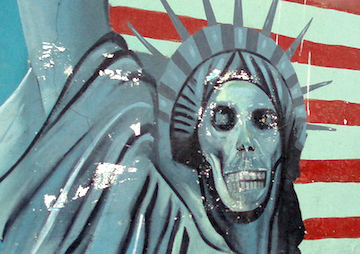For the U.S., There’s No Business Like the Arms Business
Why do major U.S. exports like Hollywood movies and Midwestern grain garner regular media coverage, while trends in weapons exports remain in relative obscurity? A mural near the former U.S. Embassy in Tehran, Iran. (David Holt / CC-BY-2.0)
1
2
3
A mural near the former U.S. Embassy in Tehran, Iran. (David Holt / CC-BY-2.0)
1
2
3

A mural near the former U.S. Embassy in Tehran, Iran. (David Holt / CC-BY-2.0)
When American firms dominate a global market worth more than $70 billion a year, you’d expect to hear about it. Not so with the global arms trade. It’s good for one or two stories a year in the mainstream media, usually when the annual statistics on the state of the business come out.
It’s not that no one writes about aspects of the arms trade. There are occasional pieces that, for example, take note of the impact of U.S. weapons transfers, including cluster bombs, to Saudi Arabia, or of the disastrous dispensation of weaponry to U.S. allies in Syria, or of foreign sales of the costly, controversial F-35 combat aircraft. And once in a while, if a foreign leader meets with the president, U.S. arms sales to his or her country might generate an article or two. But the sheer size of the American arms trade, the politics that drive it, the companies that profit from it, and its devastating global impacts are rarely discussed, much less analyzed in any depth.
So here’s a question that’s puzzled me for years (and I’m something of an arms wonk): Why do other major U.S. exports — from Hollywood movies to Midwestern grain shipments to Boeing airliners — garner regular coverage while trends in weapons exports remain in relative obscurity? Are we ashamed of standing essentially alone as the world’s number one arms dealer, or is our Weapons “R” Us role such a commonplace that we take it for granted, like death or taxes?
The numbers should stagger anyone. According to the latest figures available from the Congressional Research Service, the United States was credited with more than half the value of all global arms transfer agreements in 2014, the most recent year for which full statistics are available. At 14%, the world’s second largest supplier, Russia, lagged far behind. Washington’s “leadership” in this field has never truly been challenged. The U.S. share has fluctuated between one-third and one-half of the global market for the past two decades, peaking at an almost monopolistic 70% of all weapons sold in 2011. And the gold rush continues. Vice Admiral Joe Rixey, who heads the Pentagon’s arms sales agency, euphemistically known as the Defense Security Cooperation Agency, estimates that arms deals facilitated by the Pentagon topped $46 billion in 2015, and are on track to hit $40 billion in 2016.
To be completely accurate, there is one group of people who pay remarkably close attention to these trends — executives of the defense contractors that are cashing in on this growth market. With the Pentagon and related agencies taking in “only” about $600 billion a year — high by historical standards but tens of billions of dollars less than hoped for by the defense industry — companies like Lockheed Martin, Raytheon, and General Dynamics have been looking to global markets as their major source of new revenue.
In a January 2015 investor call, for example, Lockheed Martin CEO Marillyn Hewson was asked whether the Iran nuclear deal brokered by the Obama administration and five other powers might reduce tensions in the Middle East, undermining the company’s strategy of increasing its arms exports to the region. She responded that continuing “volatility” in both the Middle East and Asia would make them “growth areas” for the foreseeable future. In other words, no worries. As long as the world stays at war or on the verge of it, Lockheed Martin’s profits won’t suffer — and, of course, its products will help ensure that any such “volatility” will prove lethal indeed.
Under Hewson, Lockheed has set a goal of getting at least 25% of its revenues from weapons exports, and Boeing has done that company one better. It’s seeking to make overseas arms sales 30% of its business.
Good News From the Middle East (If You’re an Arms Maker)
Arms deals are a way of life in Washington. From the president on down, significant parts of the government are intent on ensuring that American arms will flood the global market and companies like Lockheed and Boeing will live the good life. From the president on his trips abroad to visit allied world leaders to the secretaries of state and defense to the staffs of U.S. embassies, American officials regularly act as salespeople for the arms firms. And the Pentagon is their enabler. From brokering, facilitating, and literally banking the money from arms deals to transferring weapons to favored allies on the taxpayers’ dime, it is in essence the world’s largest arms dealer.
In a typical sale, the U.S. government is involved every step of the way. The Pentagon often does assessments of an allied nation’s armed forces in order to tell them what they “need” — and of course what they always need is billions of dollars in new U.S.-supplied equipment. Then the Pentagon helps negotiate the terms of the deal, notifies Congress of its details, and collects the funds from the foreign buyer, which it then gives to the U.S. supplier in the form of a defense contract. In most deals, the Pentagon is also the point of contact for maintenance and spare parts for any U.S.-supplied system. The bureaucracy that helps make all of this happen, the Defense Security Cooperation Agency, is funded from a 3.5% surcharge on the deals it negotiates. This gives it all the more incentive to sell, sell, sell.
Your support matters…Independent journalism is under threat and overshadowed by heavily funded mainstream media.
You can help level the playing field. Become a member.
Your tax-deductible contribution keeps us digging beneath the headlines to give you thought-provoking, investigative reporting and analysis that unearths what's really happening- without compromise.
Give today to support our courageous, independent journalists.







You need to be a supporter to comment.
There are currently no responses to this article.
Be the first to respond.